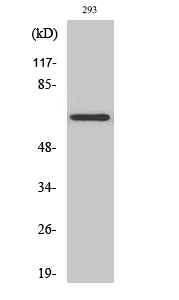产品名称
KV1.5 Rabbit Polyclonal Antibody
别名
KCNA5; Potassium voltage-gated channel subfamily A member 5; HPCN1; Voltage-gated potassium channel HK2; Voltage-gated potassium channel subunit Kv1.5
蛋白名称
Potassium voltage-gated channel subfamily A member 5
存储缓冲液
Liquid in PBS containing 50% glycerol, 0.5% BSA and 0.02% New type preservative N.
Human Gene Link
http://www.ncbi.nlm.nih.gov/sites/entrez?db=gene&term=3741
Human Swissprot No.
P22460
Human Swissprot Link
http://www.uniprot.org/uniprotkb/P22460/entry
Mouse Gene Link
http://www.ncbi.nlm.nih.gov/sites/entrez?db=gene&term=16493
Mouse Swissprot No.
Q61762
Mouse Swissprot Link
http://www.uniprot.org/uniprot/Q61762
Rat Gene Link
http://www.ncbi.nlm.nih.gov/sites/entrez?db=gene&term=25470
Rat Swissprot Link
http://www.uniprot.org/uniprot/P19024
免疫原
The antiserum was produced against synthesized peptide derived from human KCNA5. AA range:253-302
特异性
KV1.5 Polyclonal Antibody detects endogenous levels of KV1.5 protein.
稀释度
WB 1:500-2000;IHC-p 1:50-300; ELISA 2000-20000
宿主
Polyclonal, Rabbit,IgG
背景介绍
Potassium channels represent the most complex class of voltage-gated ino channels from both functional and structural standpoints. Their diverse functions include regulating neurotransmitter release, heart rate, insulin secretion, neuronal excitability, epithelial electrolyte transport, smooth muscle contraction, and cell volume. Four sequence-related potassium channel genes - shaker, shaw, shab, and shal - have been identified in Drosophila, and each has been shown to have human homolog(s). This gene encodes a member of the potassium channel, voltage-gated, shaker-related subfamily. This member contains six membrane-spanning domains with a shaker-type repeat in the fourth segment. It belongs to the delayed rectifier class, the function of which could restore the resting membrane potential of beta cells after depolarization and thereby contribute to the regulation of
组织表达
Pancreatic islets and insulinoma.
细胞定位
Cell membrane ; Multi-pass membrane protein .
功能
disease:Defects in KCNA5 are the cause of atrial fibrillation familial type 7 (ATFB7) [MIM:612240]. Atrial fibrillation is a common disorder of cardiac rhythm that is hereditary in a small subgroup of patients. It is characterized by disorganized atrial electrical activity, progressive deterioration of atrial electromechanical function and ineffective pumping of blood into the ventricles. It can be associated with palpitations, syncope, thromboembolic stroke, and congestive heart failure.,domain:The amino terminus may be important in determining the rate of inactivation of the channel while the C-terminal PDZ-binding motif may play a role in modulation of channel activity and/or targeting of the channel to specific subcellular compartments.,domain:The segment S4 is probably the voltage-sensor and is characterized by a series of positively charged amino acids at every third position.,function:Mediates the voltage-dependent potassium ion permeability of excitable membranes. Assuming opened or closed conformations in response to the voltage difference across the membrane, the protein forms a potassium-selective channel through which potasssium ions may pass in accordance with their electrochemical gradient. May play a role in regulating the secretion of insulin in normal pancreatic islets. Isoform 2 exhibits a voltage-dependent recovery from inactivation and an excessive cumulative inactivation.,PTM:Sumoylated on Lys-221, and Lys-536, preferentially by SUMO3. Sumoylation regulates the voltage sensitivity of the channel.,similarity:Belongs to the potassium channel family. A (Shaker) subfamily.,subunit:Heterotetramer of potassium channel proteins. Interacts with DLG1, which enhances channel currents. Forms a ternary complex with DLG1 and CAV3 (By similarity). Interacts with UBE2I.,tissue specificity:Pancreatic islets and insulinoma.,
纯化
The antibody was affinity-purified from rabbit antiserum by affinity-chromatography using epitope-specific immunogen.


